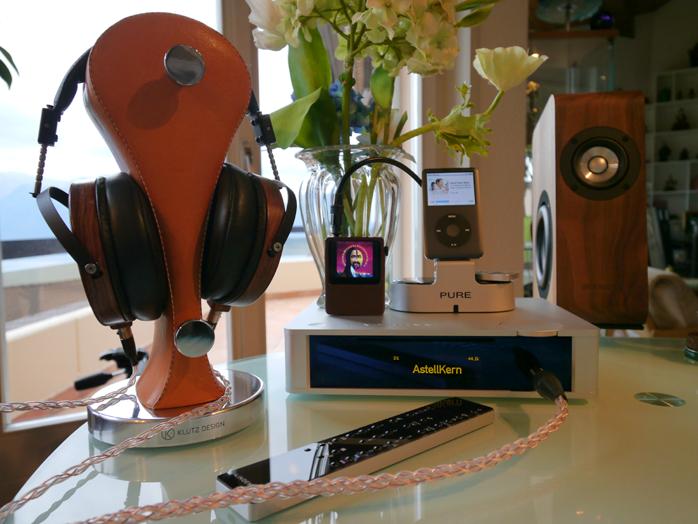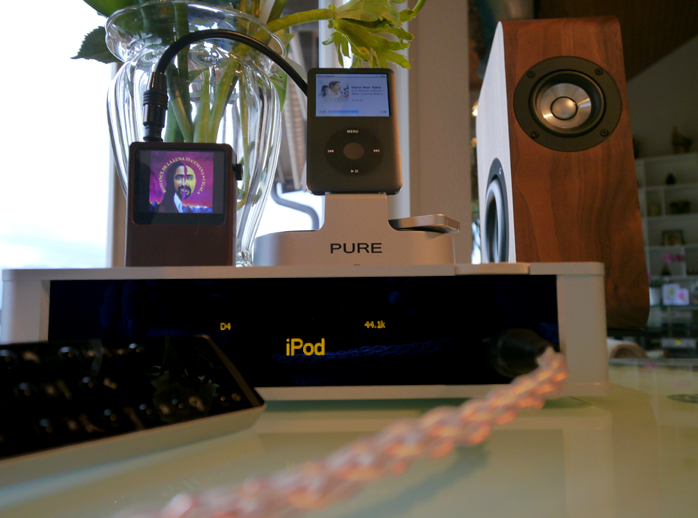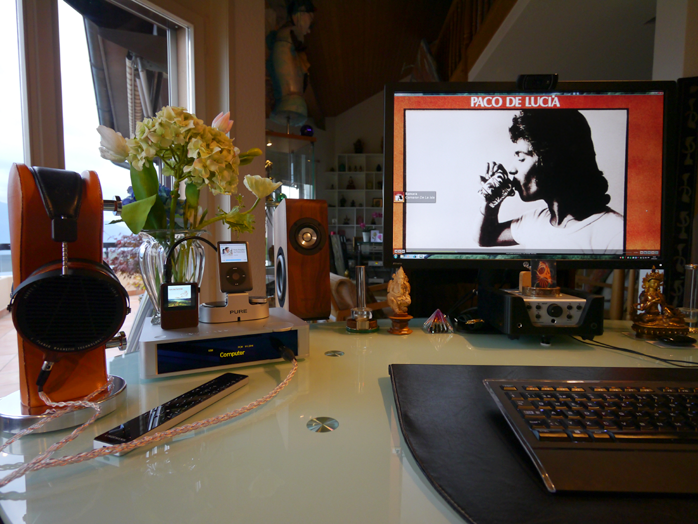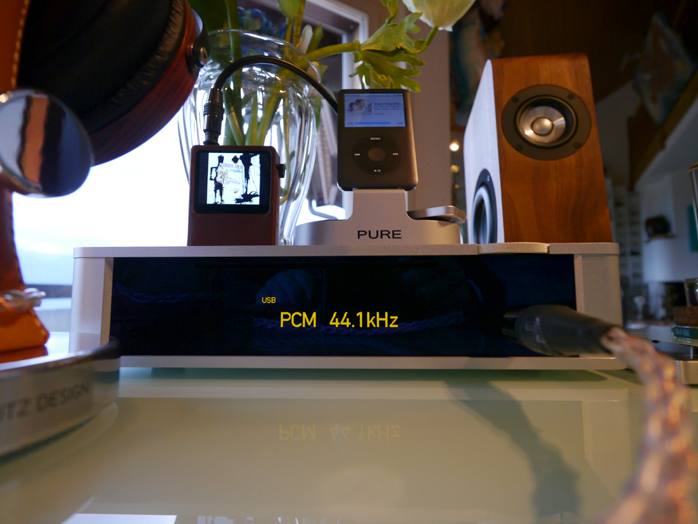This review page is supported in part by the sponsors whose ad banners are displayed below |
 |
 |
For a first pulse, I indulged in desktop headfi three different ways: RWA-modified Astell&Kern AK100 via Toslink; iPod Classic 160GB on a Pure digital dock via S/PDIF coax; and Qobuz Hifi FLAC streaming via USB over my Win7/64 HP Workstation Z230.
|
 |
|
| To do fussy just because I could (no cheating with the owner's manual required either), I deactivated all unnecessary inputs—the disc drive can't be disabled—then renamed the three remaining ones as shown. To up the ante, I hit 'play' on all three sources at once, then used the jog dial or remote to skip through them. No issues of any sort.
96kHz files* on the Korean portable promptly announced themselves as such in the display. Everything was working flawlessly. Teutonic perfectionism is a disease only if you don't suffer it but try to compete. En route to her upstairs studio, my wife passed the desk, took a look at the newcomer and volunteered high praise for its clean lines and surfaces unmarred by buttons and bolts. She particularly loved the horizontal wheel with its diamond-grid textured edge and subtly concave contour. |
|
|
| ____________________________________________________________________________________________________ |
* A 192kHz recording caused the display to flicker at that figure twice before refusing to lock just as you'd expect for optical which usually is limited to 96kHz.
|
 |
|
|
|
On Qobuz, I had a still young and fire-throated Camaron de la Isla go through Castillo De Arena with glorious intensity. With the recently departed Paco de Lucia on guitar, this warranted switching the display to full screen for some cinematic effect and to pay respects to these two giants of Flamenco. Then the job beckoned to produce commentary on sonics.
|
 |
|
 |
With my trusty Audeze LCD2v2 on their braided salt'n'pepper ALO Audio leash, it was crystal clear. It's not provenance—worrying about what source plays which presumably superior or inferior cable interface—but recording quality that wields the final trump card. A well-done piano Jazz track by the Shai Maestro Trio sounded better via the Toslink'd AK100 than a middling Elissa Pop production via USB into the sterling Asahi Kasai silicon. A deck like the musicbook:15 sets that record straight. It's not the format which wins. It's the brains and ears of the mastering studio; and whether they were paid sufficiently to give their best; or were short-changed and rushed. Give me a solid Redbook production of good music any day and twice on Sunday over a dubious 'hi-rez' title of iffy music! |
|
|
 |
On headfi, the musicbook:15 played it in deep colour, very butch and slamming as though with very low output Ω, highly damped and a bit dry. The Audeze bassists cracked a whip and shed a bit of their chocolaty gooey sinfulness in favour of grip over bloom. Key words were crisp, rollicking and tight. That can be gotten from higher feedback—and with output opamps, we expect copious amounts of NFB—but just as often it also pales in colour intensity. That's where this German up-ended prejudices. It had all the usual transistory strong points, then went one better with richly saturated timbres. The ideal comparator deck in my collection had to be Simon Lee's Eximus DP-1. On price it's a virtual stand-in for the drive-less musicbook:10. On features, the Korean's only lack is a display and remote. Otherwise both are very closely matched, including a very strong focus on chassis quality and styling. The Zodiac Gold and Platinum would belong on the same list but if memory serves, Lindemann's headphone output is quite superior. Back to the April Music.
|
|
|
Because I consider Sennheiser's HD800 more critical; and because it is the perhaps most reviewed of all dynamic statement cans to be an ideal benchmark; that's what I used for this inspection. To avoid resetting USB output devices, I stuck to the digitally tapped AIFF-loaded iPod for quick plug'n'play by just reseating the Chris Sommovigo digital leash.
|
 |
|
 |
Sonics were surprisingly evenly matched and from the same transistor class of chunky warmth. For minor differences the Korean was a bit softer/mellower in general and—without optional analog bass boost engaged—also a touch lighter down low. Starting in the upper bass and moving down from there, the German was grippier and more sharply articulated. This bestowed upon the overall feel a more driven boisterous locomotive aspect and also kicked up the black values in the colour palette. On Bebo & Cigala's "Corazón Loco" from Blanco Y Negro, neither overdid the scratchy hoarse highlights in the Gipsy dandy's top register to successfully sidestep one of the HD800's potential flaws. |
|
| Then I deliberately cued up a brighter crossover track from Gerardo Nuñez's second Jazzpana super-group outing called "Para Chick" with Jorge Pardo on traverse flute, Chano Dominguez's virile Latin piano, Renaud Garcia-Fons on bass, Perico Sambeat on saxes, Tino Di Geraldo on percussion and the quicksilvery Flamenco guitar of mister Quick Fingers. Here the Eximus' gentler handling of leading edges better forestalled the onset of whitishness which really is inherent in this recording and gets exaggerated by the Senns over planars from Audeze, MrSpeakers™ or Oppo. |
|
|
Without a close-up loupe of critical A/Bs, these decks proved quite interchangeable. They appeal to exactly the same customer. Though it's academic in practice, the Eximus betrayed its age with a 24/192 limit. For off-desk listeners who rightly insist on a remote for volume, the musicbook:15 had the undeniable advantage. Ditto for DSD acceptance. If I were multi-tasking my headfi deck as main preamp, I'd pursue the Lindemann.
|
 |
To redo fussy this time for accessorizing, I grabbed Oppo's PM1. In their silver/black boardroom chic and luxury finishing, an appointment with the stylish book felt predestined. As it had for my LCD2, the Lindemann redistributed the PM1's midrangy tendencies. Textures got a bit of a facelift stretch. The 15's brisk drive made a nice complement to the Oppo's lushness though not sufficiently so to truly crack them wide open and into the bright light of day. For that you'd want an HD800, K812 or Aëdle VK-1. If those choices struck you as too lively and caffeinated, an Oppo, Audeze or AlphaDog would be the antidote. To split the difference, HifiMan's HE-560 are ideal. They combine planar textures with dynamic treble and ended up as my bookish faves. If you spend 8 hours a day on a desk, the Lindemann would make for a top-notch all-in-one solution. Ditto as nightstand system. Add portable source with a digital output. Call it a day or night. Without doubt, the musicbook:15 is not a really great DAC with variable outputs to which was tacked a basic headfi driver on a TI chip to sell one more feature. This ¼" jack is serious just as is Nagra's HD DAC. Savvy manufacturers recognize that ambitious headfi is here to stay. They finally give it the attention it deserves. Which the music book does. Bravo!
|
 |
with Audeze LCD-XC & HifiMan HE-560, Nagra's HD DAC and Goldmund's HDA
|
To get to the next and arguably ultimate and final level in this component league will set you back 8'600 Swiss for Goldmund's Telos headphone amplifier. From there (or something like a Crayon CHA-1 or Bakoon AMP-12R, both sans DAC), one jumps straight into Lindemann turf. Nothing of note lives in-between. That's how the law of diminishing returns works here.
|
 |
  |
 |